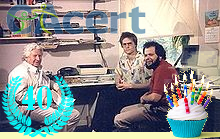Twenty-one years ago today, CAcert Inc was founded as the organisation behind the CAcert community. However, the rather crazy story of CAcert began the year before: Australian Duane Groth founded the CAcert community in 2002 with the aim to offer digital certificates for everyone to form such a confidence and safety consciousness in and around the Internet. He wanted to secure the WLAN network of his hometown, which was too expensive, so started the community.

It soon became clear that the operation of a certificate authorithy requires certain structures. This is why the three-part structure of CAcert was invented:
- the community of all users, teams and assurers where no one can take power or control; resolutions takes a kind of parliament (legislature), the Policy Group, in which any interested member of the community can participate
- the association CAcert Inc with an elected committee (executive), which manages the business for the community as a legal entity
- a mediation body, called arbitration, the judiciary
These three parts are bound together by the CAcert Community Agreement, or CCA for short. The CCA is recognised by all members of the community and the association, but also by all users of a certificate. In addition, this recognition is renewed each time a certificate is created or renewed. The CCA is therefore an extremely strong bond that holds together the several hundred thousand members of the community with CAcert Inc and Arbtration. CAcert Inc was registered in New South Wales 20 years ago today. Today CAcert Inc is based in Switzerland.
Über zwanzig Jahre «CAcert Inc» – eine Erfolgsgeschichte (deutsch)
Heute vor einundzwanzig Jahren wurde CAcert Inc. als die Organisation hinter der CAcert-Gemeinschaft gegründet. Die ziemlich verrückte Geschichte von CAcert begann jedoch schon im Jahr zuvor: Der Australier Duane Groth gründete 2002 die CAcert-Gemeinschaft mit dem Ziel, digitale Zertifikate für jedermann anzubieten, um so ein Vertrauens- und Sicherheitsbewusstsein im und um das Internet zu bilden. Er wollte das WLAN-Netz seiner Heimatstadt sichern, was aber zu teuer war, und gründete deshalb die Gemeinschaft. Schnell wurde klar, dass der Betrieb einer Zertifikatsautorität bestimmte Strukturen erfordert. Aus diesem Grund wurde die dreiteilige Struktur von CAcert erfunden:
• die Gemeinschaft aller Nutzer, den Teams und Assurern in der niemand Macht oder Kontrolle ausüben kann; Beschlüsse fasst eine Art Parlament (Legislative), die Policy Group, an der jedes interessierte Mitglied der Gemeinschaft teilnehmen kann
• der Verein CAcert Inc mit einem gewählten Vorstand (Exekutive), der als juristische Person die Geschäfte für die Gemeinschaft führt
• eine Schlichtungsstelle, das sogenannte Schiedsgericht, die Judikative
Diese drei Teile sind durch das CAcert Community Agreement, kurz CCA, miteinander verbunden. Das CCA wird von allen Mitgliedern der Gemeinschaft und des Vereins, aber auch von allen Nutzern eines Zertifikats anerkannt. Außerdem wird diese Anerkennung jedes Mal erneuert, wenn ein Zertifikat erstellt oder verlängert wird. Die CCA ist also ein äußerst starkes Band, das die mehreren hunderttausend Mitglieder der Gemeinschaft mit CAcert Inc und Arbtration zusammenhält. Heute vor 20 Jahren wurde CAcert Inc. in Neusüd-Wales registriert. Heute hat CAcert Inc. seinen Sitz in der Schweiz.
Plus que vingt ans de «CAcert Inc» – une histoire à succès (français)
Il y a vingt et un ans aujourd’hui, CAcert Inc. a été fondée en tant qu’organisation de patronage de la communauté CAcert. Cependant, l’histoire un peu folle de CAcert a commencé l’année précédente : L’Australien Duane Groth a fondé la communauté CAcert en 2002 dans le but d’offrir des certificats numériques à tout le monde afin de créer une conscience de confiance et de sécurité sur et autour de l’internet. Il souhaitait sécuriser le réseau WLAN de sa ville natale, qui était trop coûteux, et a donc créé la communauté. Il est rapidement apparu que le fonctionnement d’une autorité de certification nécessitait certaines structures. C’est pourquoi la structure en trois parties de CAcert a été inventée:
• la communauté de tous les utilisateurs, équipes et assuers où personne ne peut prendre le pouvoir ou le contrôle; les décisions sont pris par une sorte de parlement (législature), le Policy Group, auquel tout membre intéressé de la communauté peut participer
• l’association CAcert Inc avec un comité élu (exécutif), qui gère les affaires pour la communauté en tant qu’entité juridique
• un organe de médiation, appelé arbitration, le pouvoir judiciaire.
Ces trois parties sont liées par l’accord communautaire de CAcert, ou CCA en abrégé. Le CCA est reconnu par tous les membres de la communauté et de l’association, mais aussi par tous les utilisateurs d’un certificat. De plus, cette reconnaissance est renouvelée à chaque fois qu’un certificat est créé ou renouvelé. Le CCA est donc un lien extrêmement fort qui unit les quelques centaines de milliers de membres de la communauté à CAcert Inc et Arbtration. CAcert Inc a été enregistré en Nouvelle-Galles du Sud il y a 20 ans aujourd’hui. Aujourd’hui, CAcert Inc est basée en Suisse.


